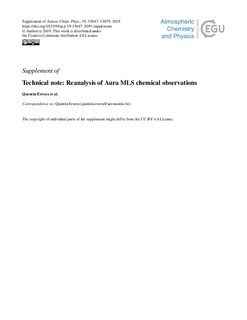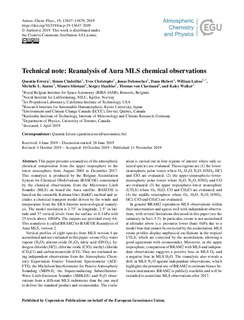| dc.description.abstract | This paper presents a reanalysis of the atmospheric chemical composition from the upper troposphere to the lower mesosphere from August 2004 to December 2017. This reanalysis is produced by the Belgian Assimilation System for Chemical ObsErvations (BASCOE) constrained by the chemical observations from the Microwave Limb Sounder (MLS) on board the Aura satellite. BASCOE is based on the ensemble Kalman filter (EnKF) method and includes a chemical transport model driven by the winds and temperature from the ERA-Interim meteorological reanalysis. The model resolution is 3.75∘ in longitude, 2.5∘ in latitude and 37 vertical levels from the surface to 0.1 hPa with 25 levels above 100 hPa. The outputs are provided every 6 h. This reanalysis is called BRAM2 for BASCOE Reanalysis of Aura MLS, version 2. Vertical profiles of eight species from MLS version 4 are assimilated and are evaluated in this paper: ozone (O3), water vapour (H2O), nitrous oxide (N2O), nitric acid (HNO3), hydrogen chloride (HCl), chlorine oxide (ClO), methyl chloride (CH3Cl) and carbon monoxide (CO). They are evaluated using independent observations from the Atmospheric Chemistry Experiment Fourier Transform Spectrometer (ACE-FTS), the Michelson Interferometer for Passive Atmospheric Sounding (MIPAS), the Superconducting Submillimeter-Wave Limb-Emission Sounder (SMILES) and N2O observations from a different MLS radiometer than the one used to deliver the standard product and ozonesondes. The evaluation is carried out in four regions of interest where only selected species are evaluated. These regions are (1) the lower-stratospheric polar vortex where O3, H2O, N2O, HNO3, HCl and ClO are evaluated; (2) the upper-stratospheric–lower-mesospheric polar vortex where H2O, N2O, HNO3 and CO are evaluated; (3) the upper troposphere–lower stratosphere (UTLS) where O3, H2O, CO and CH3Cl are evaluated; and (4) the middle stratosphere where O3, H2O, N2O, HNO3, HCl, ClO and CH3Cl are evaluated. In general BRAM2 reproduces MLS observations within their uncertainties and agrees well with independent observations, with several limitations discussed in this paper (see the summary in Sect. 5.5). In particular, ozone is not assimilated at altitudes above (i.e. pressures lower than) 4 hPa due to a model bias that cannot be corrected by the assimilation. MLS ozone profiles display unphysical oscillations in the tropical UTLS, which are corrected by the assimilation, allowing a good agreement with ozonesondes. Moreover, in the upper troposphere, comparison of BRAM2 with MLS and independent observations suggests a positive bias in MLS O3 and a negative bias in MLS H2O. The reanalysis also reveals a drift in MLS N2O against independent observations, which highlights the potential use of BRAM2 to estimate biases between instruments. BRAM2 is publicly available and will be extended to assimilate MLS observations after 2017. | nb_NO |


